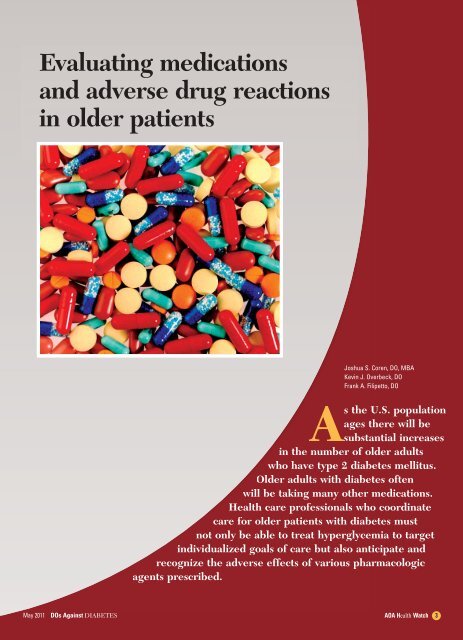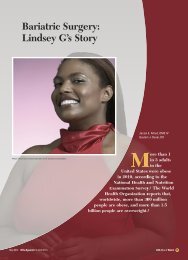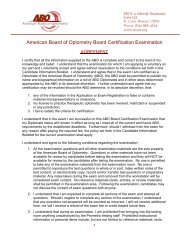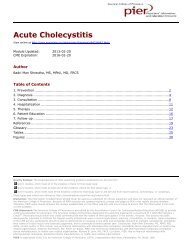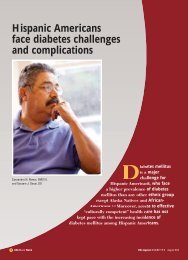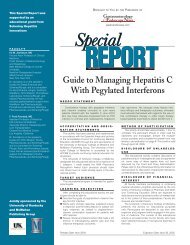Evaluating medications and adverse drug reactions in older ... - CECity
Evaluating medications and adverse drug reactions in older ... - CECity
Evaluating medications and adverse drug reactions in older ... - CECity
You also want an ePaper? Increase the reach of your titles
YUMPU automatically turns print PDFs into web optimized ePapers that Google loves.
<strong>Evaluat<strong>in</strong>g</strong> <strong>medications</strong><br />
<strong>and</strong> <strong>adverse</strong> <strong>drug</strong> <strong>reactions</strong><br />
<strong>in</strong> <strong>older</strong> patients<br />
Joshua S. Coren, DO, MBA<br />
Kev<strong>in</strong> J. Overbeck, DO<br />
Frank A. Filipetto, DO<br />
As the U.S. population<br />
ages there will be<br />
substantial <strong>in</strong>creases<br />
<strong>in</strong> the number of <strong>older</strong> adults<br />
who have type 2 diabetes mellitus.<br />
Older adults with diabetes often<br />
will be tak<strong>in</strong>g many other <strong>medications</strong>.<br />
Health care professionals who coord<strong>in</strong>ate<br />
care for <strong>older</strong> patients with diabetes must<br />
not only be able to treat hyperglycemia to target<br />
<strong>in</strong>dividualized goals of care but also anticipate <strong>and</strong><br />
recognize the <strong>adverse</strong> effects of various pharmacologic<br />
agents prescribed.<br />
May 2011 DOs Aga<strong>in</strong>st DIABETES<br />
AOA Health Watch<br />
3
Prescriber knowledge about <strong>drug</strong><br />
pharmacodynamics <strong>and</strong> pharmacok<strong>in</strong>etics<br />
<strong>and</strong> their <strong>in</strong>teraction with normally<br />
ag<strong>in</strong>g physiology is critical <strong>in</strong> treat<strong>in</strong>g<br />
the elderly patient with diabetes.<br />
This knowledge is needed to m<strong>in</strong>imize<br />
<strong>and</strong> even avoid the potentially <strong>adverse</strong><br />
effects of hypoglycemia <strong>and</strong> the side<br />
effects associated with polypharmacy.<br />
When <strong>medications</strong> become necessary<br />
to the management of diabetes <strong>in</strong> an<br />
<strong>older</strong> patient, <strong>in</strong>formed practitioners can<br />
correctly <strong>and</strong> safely write a prescription<br />
for the proper <strong>drug</strong>, dose <strong>and</strong> frequency.<br />
Pharmacodynamics<br />
When evaluat<strong>in</strong>g the pharmacodynamic<br />
effects of a <strong>drug</strong> on a body, the patient’s<br />
age, comorbid conditions <strong>and</strong> concurrent<br />
<strong>medications</strong> should be considered. 1<br />
An <strong>older</strong> patient may exhibit alterations<br />
<strong>in</strong> receptor aff<strong>in</strong>ity or number <strong>and</strong><br />
signal transduction mechanisms,<br />
<strong>and</strong> impairment of cellular response<br />
<strong>in</strong> affected organs that <strong>in</strong>fluence<br />
the pharmacodynamics of a particular<br />
medication. 2,3<br />
Pharmacodynamic effects commonly<br />
encountered with regard to neurologic<br />
<strong>and</strong> cardiac function<strong>in</strong>g via the<br />
autonomic <strong>and</strong> central nervous system<br />
also play a role <strong>in</strong> pharmacotherapy for<br />
diabetes. Drug sensitivity may <strong>in</strong>crease<br />
<strong>in</strong> <strong>older</strong> patients when the cellular<br />
response to a given pharmaceutical<br />
concentration is enhanced. 4<br />
Physicians must realize that enhanced<br />
concentration of some <strong>medications</strong>,<br />
such as the sulfonylureas, can <strong>in</strong>crease<br />
the <strong>in</strong>cidence of hypoglycemia <strong>in</strong> <strong>older</strong><br />
patients more than <strong>in</strong> younger patients. 5<br />
<strong>Evaluat<strong>in</strong>g</strong> each diabetic medication<br />
<strong>and</strong> its respective pharmacodynamic<br />
properties is imperative to reduce<br />
the risk of these potential effects.<br />
Pharmacok<strong>in</strong>etics<br />
Pharmacok<strong>in</strong>etics <strong>in</strong>volves the effect<br />
of body on a <strong>drug</strong> dur<strong>in</strong>g the course of<br />
travel from absorption, bioavailability,<br />
distribution <strong>and</strong> metabolism through<br />
excretion. 6 Many classes of diabetic<br />
<strong>medications</strong> are taken orally <strong>and</strong><br />
absorbed via the gastro<strong>in</strong>test<strong>in</strong>al tract.<br />
A net neutral absorption effect<br />
of decreased <strong>in</strong>test<strong>in</strong>al motility is likely<br />
<strong>in</strong> the <strong>older</strong> patient, which <strong>in</strong>creases<br />
the time for <strong>drug</strong> absorption <strong>in</strong> the<br />
otherwise normal gastro<strong>in</strong>test<strong>in</strong>al tract<br />
that may be offset by the patient’s<br />
<strong>in</strong>creas<strong>in</strong>g pH level. 7-9 With normal<br />
ag<strong>in</strong>g, there is a decrease <strong>in</strong> lean body<br />
mass, water volume <strong>and</strong> organ blood<br />
flow, with a concomitant <strong>in</strong>crease <strong>in</strong><br />
adipose tissue, mak<strong>in</strong>g it imperative<br />
that the practitioner choose the lowest<br />
possible effective dose for the patient.<br />
Renal <strong>and</strong> hepatic elim<strong>in</strong>ation of<br />
diabetic <strong>medications</strong> is certa<strong>in</strong>ly a ma<strong>in</strong><br />
concern of providers car<strong>in</strong>g for <strong>older</strong><br />
<strong>in</strong>patient <strong>and</strong> outpatient populations.<br />
Some of the most common disease<strong>in</strong>duced<br />
changes can affect both liver<br />
<strong>and</strong> kidney function, further lead<strong>in</strong>g<br />
to vary<strong>in</strong>g pharmacok<strong>in</strong>etics <strong>and</strong><br />
<strong>drug</strong> elim<strong>in</strong>ation. These issues make<br />
treat<strong>in</strong>g the <strong>older</strong> adult with diabetes<br />
even more challeng<strong>in</strong>g.<br />
Adverse <strong>drug</strong> <strong>reactions</strong><br />
The most common <strong>and</strong> one of the most<br />
devastat<strong>in</strong>g side effects of pharmacologic<br />
treatment of <strong>older</strong> patients is hypoglycemia.<br />
The risk of severe or fatal hypoglycemia<br />
exponentially <strong>in</strong>creases with age. 10<br />
The l<strong>and</strong>mark trial Action to Control<br />
Cardiovascular Risk <strong>in</strong> Diabetes, or<br />
ACCORD, was discont<strong>in</strong>ued early when<br />
<strong>in</strong>terim results <strong>in</strong>dicated a statistically<br />
significant <strong>in</strong>crease <strong>in</strong> mortality <strong>in</strong><br />
patients who received <strong>in</strong>tensive therapy<br />
with the goal of achiev<strong>in</strong>g a glycated<br />
hemoglob<strong>in</strong> level of 6% or less. Further<br />
analysis of data from this trial showed<br />
that <strong>in</strong>dividuals <strong>in</strong> this group used more<br />
medication <strong>and</strong> had more hypoglycemic<br />
events, greater weight ga<strong>in</strong> <strong>and</strong> greater<br />
fluid retention than <strong>in</strong>dividuals <strong>in</strong> the<br />
group that received st<strong>and</strong>ard therapy<br />
with the goal of a glycated hemoglob<strong>in</strong><br />
level of 7% to 7.9%. 11<br />
Although the Action <strong>in</strong> Diabetes<br />
<strong>and</strong> Vascular Disease: Preterax <strong>and</strong><br />
Diamicron Modified Release Controlled<br />
Evaluation, or ADVANCE trial, which<br />
similarly compared <strong>in</strong>tensive blood sugar<br />
control to st<strong>and</strong>ard therapy, did not<br />
show a difference <strong>in</strong> mortality between<br />
the two groups, it did demonstrate an<br />
<strong>in</strong>crease <strong>in</strong> the number of hypoglycemic<br />
events <strong>and</strong> hospitalization <strong>in</strong> those who<br />
were more <strong>in</strong>tensively treated. 12 In light<br />
of these f<strong>in</strong>d<strong>in</strong>gs, the American Diabetes<br />
Association has recommended that goals<br />
be <strong>in</strong>dividualized, with more flexible<br />
goals for <strong>older</strong> adults, those with<br />
advanced disease <strong>and</strong> complications<br />
or those with limited life expectancy. 13<br />
Older patients also may experience<br />
delayed psychomotor responses as<br />
a result of <strong>in</strong>terventions designed<br />
4<br />
AOA Health Watch<br />
DOs Aga<strong>in</strong>st DIABETES May 2011
to correct hypoglycemia. 14 Glucagon,<br />
one of the ma<strong>in</strong> counter-regulatory<br />
responses to hypoglycemia, is impaired<br />
<strong>in</strong> <strong>older</strong> people <strong>and</strong>, to a greater<br />
extent, <strong>older</strong> patients with diabetes. 15<br />
Altered psychomotor <strong>and</strong> impaired<br />
counter-regulatory responses must<br />
be balanced with the functional <strong>and</strong><br />
cognitive status of the <strong>in</strong>dividual.<br />
In addition to be<strong>in</strong>g aware of <strong>and</strong><br />
recogniz<strong>in</strong>g hypoglycemia, patients<br />
must be able to access food or dr<strong>in</strong>k<br />
to reverse this iatrogenic condition.<br />
Hypoglycemia manifests through<br />
an easily recognizable adrenergic<br />
constellation of symptoms, most notably<br />
tremor, sweats or weakness. However,<br />
<strong>older</strong> patients commonly demonstrate<br />
a primarily neuroglycopenic syndrome<br />
(i.e., confusion, delirium, dizz<strong>in</strong>ess <strong>and</strong><br />
falls) that can be misdiagnosed as a<br />
neurologic event such as a transient<br />
ischemic attack or syncope.<br />
Listed below are some common<br />
classes of <strong>medications</strong> prescribed<br />
for diabetes. Although this is not a<br />
comprehensive list of <strong>medications</strong><br />
<strong>and</strong> correspond<strong>in</strong>g <strong>adverse</strong> events,<br />
notes are provided on the potential<br />
for <strong>adverse</strong> <strong>reactions</strong> <strong>in</strong> this population.<br />
Clear provider <strong>in</strong>structions <strong>and</strong> patient<br />
(or caregiver) comprehension are<br />
essential to ensure directed <strong>drug</strong><br />
dos<strong>in</strong>g, tim<strong>in</strong>g <strong>and</strong> adm<strong>in</strong>istration.<br />
Commonly prescribed<br />
<strong>medications</strong><br />
Thiazolid<strong>in</strong>ediones<br />
Adverse events associated with the<br />
thiazolid<strong>in</strong>ediones are weight ga<strong>in</strong>,<br />
edema, macular edema, congestive<br />
heart failure, <strong>in</strong>creased bone fracture<br />
risk <strong>and</strong>, when comb<strong>in</strong>ed with other<br />
diabetic <strong>medications</strong>, hypoglycemia. 16<br />
Of notable mention are several studies<br />
that suggest the potential for <strong>adverse</strong><br />
cardiovascular events with rosiglitazone<br />
<strong>and</strong> potential for benefits <strong>in</strong> cardiovascular<br />
risk reduction from pioglitazone. 17-19<br />
Further studies are needed regard<strong>in</strong>g<br />
these events <strong>and</strong> how they affect<br />
the <strong>older</strong> population with diabetes.<br />
Ongo<strong>in</strong>g concerns about fluid retention<br />
limit the utility of these studies for<br />
<strong>older</strong> patients with diabetes.<br />
Biguanide<br />
Patients will commonly experience<br />
gastro<strong>in</strong>test<strong>in</strong>al side effects that tend<br />
to improve after the first few weeks of<br />
treatment with metform<strong>in</strong>. Metform<strong>in</strong><br />
should not be used <strong>in</strong> <strong>in</strong>dividuals <strong>older</strong><br />
than age 80 until renal function has<br />
been established. Lactic acidosis is<br />
a potential side effect of metform<strong>in</strong>,<br />
yet evidence is scant that it will<br />
occur with contra<strong>in</strong>dications to<br />
metform<strong>in</strong>. 20,21 The biguanide class<br />
is also contra<strong>in</strong>dicated <strong>in</strong> patients<br />
with renal disease, renal dysfunction<br />
or abnormal creat<strong>in</strong><strong>in</strong>e clearance rates.<br />
Sulfonylureas<br />
As previously mentioned, hypoglycemia<br />
is a notable <strong>adverse</strong> event that can<br />
occur with the sulfonylurea class of<br />
<strong>drug</strong>s. There are conflict<strong>in</strong>g data on<br />
whether the sulfonylurea class <strong>in</strong>creases<br />
the risk of cardiovascular events, <strong>and</strong><br />
further research is needed. 22-24 Older<br />
patients should be <strong>in</strong>structed about the<br />
potential for weight ga<strong>in</strong> as more <strong>in</strong>sul<strong>in</strong><br />
is produced <strong>and</strong> glucose is utilized.<br />
Meglit<strong>in</strong>ides<br />
Weight ga<strong>in</strong> is a common feature of<br />
this class that <strong>in</strong>cludes the <strong>medications</strong><br />
repagl<strong>in</strong>ide <strong>and</strong> nategl<strong>in</strong>ide. Although<br />
hypoglycemia is a possible side effect,<br />
mealtime dos<strong>in</strong>g of meglit<strong>in</strong>ides enables<br />
<strong>older</strong> patients to be flexible with their<br />
dos<strong>in</strong>g schedule. Repagl<strong>in</strong>ide may also<br />
be a good choice for an <strong>older</strong> patient or<br />
a patient with renal disease, as 90% of<br />
the <strong>drug</strong> can be recovered <strong>in</strong> the feces. 25<br />
Insul<strong>in</strong> therapy<br />
Insul<strong>in</strong> is often an underutilized<br />
therapeutic modality <strong>in</strong> the <strong>older</strong><br />
patient with diabetes because of the<br />
practitioner’s, patient’s or family’s<br />
concerns about adm<strong>in</strong>istration <strong>and</strong><br />
the risk of hypoglycemia. 26 Weight<br />
ga<strong>in</strong> is another common <strong>adverse</strong> effect<br />
of <strong>in</strong>sul<strong>in</strong> products. Patients should be<br />
appropriately educated on the proper<br />
adm<strong>in</strong>istration, dos<strong>in</strong>g <strong>and</strong> effects<br />
of the various <strong>in</strong>sul<strong>in</strong> products.<br />
Visual <strong>and</strong> cognitive acuity<br />
should be assessed prior to <strong>in</strong>itiat<strong>in</strong>g<br />
<strong>and</strong> tailor<strong>in</strong>g products to ensure<br />
that patients can easily adm<strong>in</strong>ister<br />
the amount of <strong>in</strong>sul<strong>in</strong> prescribed.<br />
Specifically, the use of <strong>in</strong>sul<strong>in</strong> pens<br />
can greatly assist <strong>older</strong> adults who<br />
may have issues with vision or dexterity.<br />
In some of the pens the correct dose<br />
can be achieved even with clicks of<br />
the pen, ensur<strong>in</strong>g more accurate dos<strong>in</strong>g.<br />
With the advent of long-act<strong>in</strong>g, oncedaily-adm<strong>in</strong>istered<br />
<strong>in</strong>sul<strong>in</strong> formulations,<br />
capable <strong>and</strong> will<strong>in</strong>g caregivers can<br />
often assist the <strong>older</strong> <strong>in</strong>dividual<br />
with this pharmacologic <strong>in</strong>tervention.<br />
May 2011<br />
DOs Aga<strong>in</strong>st DIABETES<br />
AOA Health Watch<br />
5
Dipeptidyl Peptidase-4 Inhibitors<br />
Sitaglipt<strong>in</strong>, a dipeptidyl peptidase-4<br />
(DPP-4) <strong>in</strong>hibitor, has a favorable<br />
safety profile, <strong>and</strong> a low <strong>in</strong>cidence<br />
of hypoglycemia. Nausea generally<br />
resolves with dos<strong>in</strong>g strategies dur<strong>in</strong>g<br />
the <strong>in</strong>troduction of the medication. 27<br />
Sitaglipt<strong>in</strong> is be<strong>in</strong>g <strong>in</strong>vestigated to<br />
determ<strong>in</strong>e whether it is l<strong>in</strong>ked to acute<br />
pancreatitis. 28,29 Abdom<strong>in</strong>al pa<strong>in</strong> <strong>and</strong><br />
substantially decreased appetite should<br />
be cause to discont<strong>in</strong>ue this medication.<br />
Saxaglipt<strong>in</strong> has a similar <strong>adverse</strong> effect<br />
profile but is associated with a decrease<br />
<strong>in</strong> the absolute lymphocyte count (this<br />
was not observed at the 2.5 mg dose). 30<br />
Although the cl<strong>in</strong>ical importance of<br />
this laboratory f<strong>in</strong>d<strong>in</strong>g has not been<br />
firmly established, saxaglipt<strong>in</strong> has been<br />
associated with an <strong>in</strong>creased number<br />
of upper respiratory <strong>in</strong>fections,<br />
as well as ur<strong>in</strong>ary tract <strong>in</strong>fections. 31<br />
Repeated <strong>in</strong>fections should prompt<br />
a review of saxaglipt<strong>in</strong>’s cl<strong>in</strong>ical utility<br />
<strong>in</strong> the <strong>in</strong>dividual’s case. Despite an<br />
<strong>in</strong>creased f<strong>in</strong>ancial burden for the<br />
elderly, DPP-4 <strong>in</strong>hibitors may be<br />
particularly useful <strong>in</strong> <strong>older</strong> adults,<br />
s<strong>in</strong>ce they exhibit few <strong>drug</strong>-to-<strong>drug</strong><br />
<strong>in</strong>teractions. In addition, these<br />
<strong>medications</strong> can be used <strong>in</strong> adults<br />
with all stages of renal disease,<br />
<strong>in</strong>clud<strong>in</strong>g end-stage renal disease<br />
(but dosage adjustment is needed).<br />
Incret<strong>in</strong> mimetics<br />
Exenatide has a favorable safety<br />
profile, with <strong>adverse</strong> events of<br />
dizz<strong>in</strong>ess, headache <strong>and</strong> gastro<strong>in</strong>test<strong>in</strong>al<br />
discomfort. 27 Incret<strong>in</strong> mimetics is<br />
be<strong>in</strong>g <strong>in</strong>vestigated to determ<strong>in</strong>e whether<br />
it is l<strong>in</strong>ked to acute pancreatitis <strong>and</strong><br />
thyroid cancer. 28, 29, 32 Liraglutide<br />
has a similar safety concern but carries<br />
the benefit of once daily dos<strong>in</strong>g<br />
adm<strong>in</strong>istered <strong>in</strong> a pre-filled pen.<br />
S<strong>in</strong>ce weight loss can be substantial <strong>in</strong><br />
patients us<strong>in</strong>g this medication, the role<br />
of <strong>in</strong>cret<strong>in</strong> mimetics is limited <strong>in</strong> the<br />
vulnerable or frail elderly population. 33<br />
Polypharmacy<br />
The adm<strong>in</strong>istration of multiple<br />
pharmaceutical products <strong>in</strong> concert<br />
(known as polypharmacy) may potentiate<br />
or decrease the effects of common<br />
diabetes <strong>medications</strong> <strong>in</strong> the <strong>older</strong><br />
population. Such patients commonly<br />
have other systemic, related chronic<br />
conditions; the physician must recognize<br />
the variety of <strong>medications</strong> the patient<br />
may be tak<strong>in</strong>g <strong>and</strong> the potential<br />
<strong>in</strong>teractions among these <strong>medications</strong>.<br />
In one study of 18,968 patients with<br />
diabetes, at least 16% were dispensed<br />
a medic<strong>in</strong>e that is associated with<br />
<strong>adverse</strong> <strong>in</strong>teractions, <strong>and</strong> 22.7% were<br />
dispensed at least one potentially<br />
<strong>in</strong>appropriate medic<strong>in</strong>e. 34<br />
Every six to 12 months, physicians<br />
should request that their <strong>older</strong> patients<br />
br<strong>in</strong>g their <strong>medications</strong> with them to their<br />
appo<strong>in</strong>tments as an audit for usage <strong>and</strong><br />
also as an educational opportunity. This<br />
“brown bag” medication review is one<br />
method to avert potential polypharmacy. 35<br />
Physicians should also strive to partner<br />
with family members who are often<br />
caregivers for these patients.<br />
F<strong>in</strong>al notes<br />
As ag<strong>in</strong>g is a risk factor for chronic<br />
care conditions such as diabetes,<br />
physicians are faced with a grow<strong>in</strong>g<br />
population of <strong>older</strong> patients with this<br />
disorder. Ensur<strong>in</strong>g that patients are<br />
educated on both their <strong>medications</strong><br />
<strong>and</strong> potential <strong>adverse</strong> events is a<br />
necessity <strong>in</strong> every care plan to limit<br />
potential treatment complications.<br />
6<br />
AOA Health Watch<br />
DOs Aga<strong>in</strong>st DIABETES May 2011
References<br />
1. Moroney A. Drug receptor <strong>in</strong>teractions.<br />
The Merck Manuals Onl<strong>in</strong>e Medical Library<br />
Web site. Cl<strong>in</strong>ical pharmacology:<br />
pharmacodynamics-<strong>drug</strong>-receptor <strong>in</strong>teractio<strong>in</strong>s.<br />
http://www.merckmanuals.com/ professional/<br />
sec20/ch304/ch304b.html. Published<br />
November 2007. Accessed January 24, 2011.<br />
2. Chapron DJ. Influence of advanced age on <strong>drug</strong><br />
disposition <strong>and</strong> response. In: Delafuente JC,<br />
Stewart RB, eds. Therapeutics <strong>in</strong> the Elderly.<br />
Baltimore, MD: Williams <strong>and</strong> Wilk<strong>in</strong>s; 1988:107-120.<br />
3. Feely J, Coakley D. Altered pharmacodynamics <strong>in</strong><br />
the elderly. Cl<strong>in</strong> Geriatr Med. 1990;6(2):269-283.<br />
4. Turnheim K. When <strong>drug</strong> therapy gets old:<br />
pharmacok<strong>in</strong>etics <strong>and</strong> pharmacodynamics <strong>in</strong><br />
the elderly. Exp Gerontol. 2003;38(8):843-853.<br />
5. Doucet J. Use of antidiabetic <strong>drug</strong>s <strong>in</strong> elderly patients.<br />
Diabetes Metab. 2005;31(suppl 1):5S98-5S104.<br />
6. Rusc<strong>in</strong> JM. The Merck Manuals Onl<strong>in</strong>e<br />
Medical Library Web site. Cl<strong>in</strong>ical pharmacology.<br />
Geriatrics: <strong>drug</strong> therapy <strong>in</strong> the elderlypharmacok<strong>in</strong>etics<br />
<strong>in</strong> the elderly. http://www.<br />
merckmanuals.com/professional/sec23/ch341/<br />
ch341b.html#CHDCDDJB. Published September 2009.<br />
Accessed January 24, 2011.<br />
7. Bressler R, Bahl JJ. Pr<strong>in</strong>ciples of <strong>drug</strong> therapy<br />
for the elderly patient. Mayo Cl<strong>in</strong> Proc.<br />
2003;78(12):1564-1577.<br />
8. Dawl<strong>in</strong>g S, Crome P. Cl<strong>in</strong>ical pharmacok<strong>in</strong>etic<br />
considerations <strong>in</strong> the elderly: an update.<br />
Cl<strong>in</strong> Pharmacok<strong>in</strong>et. 1989;17(4):236-263.<br />
9. Nielson CP, Cusack BJ, Vestal RE.<br />
Geriatric cl<strong>in</strong>ical pharmacology <strong>and</strong><br />
therapeutics. In: Speight TM, ed. Avery’s<br />
Drug Treatment: Pr<strong>in</strong>ciples <strong>and</strong> Practice<br />
of Cl<strong>in</strong>ical Pharmacology <strong>and</strong> Therapeutics.<br />
3rd ed. Auckl<strong>and</strong>, New Zeal<strong>and</strong>:<br />
Churchill Liv<strong>in</strong>gstone; 1987:162-193.<br />
10. Stepka M, Rogala H, Czyzyk A.<br />
Hypoglycemia: a major problem <strong>in</strong><br />
the management of diabetes <strong>in</strong> the elderly.<br />
Ag<strong>in</strong>g (Milano). 1993;5(2):117-121.<br />
11. The Action to Control Cardiovascular Risk<br />
<strong>in</strong> Diabetes Study Group. Effects of <strong>in</strong>tensive<br />
glucose lower<strong>in</strong>g <strong>in</strong> type 2 diabetes.<br />
N Engl J Med. 2008;358(24):2545-2559.<br />
12. The ADVANCE Collaborative Group.<br />
Intensive blood glucose control <strong>and</strong> vascular<br />
outcomes <strong>in</strong> patients with type 2 diabetes.<br />
N Engl J Med. 2008;358(24):2560-2572.<br />
13. American Diabetes Association. St<strong>and</strong>ards<br />
of medical care <strong>in</strong> diabetes: 2011.<br />
Diabetes Care. 2011;34(suppl 1):S11-S61.<br />
14. Thomson FJ, Masson EA, Leem<strong>in</strong>g JT,<br />
Boulton AJ. Lack of knowledge of symptoms<br />
of hypoglycaemia by elderly diabetic patients.<br />
Age Age<strong>in</strong>g. . 1991;20(6):404-406.<br />
15. Meneilly GS, Cheung E, Tuokko H.<br />
Counterregulatory hormone responses<br />
to hypoglycemia <strong>in</strong> the elderly patient<br />
with diabetes. Diabetes. 1994;43(3):403-410.<br />
16. Rizos CV, Elisaf MS, Mikhailidis DP,<br />
Liberopoulos EN. How safe is the use<br />
of thiazolid<strong>in</strong>ediones <strong>in</strong> cl<strong>in</strong>ical practice?<br />
Expert Op<strong>in</strong> Drug Saf. 2009;8(1):15-32.<br />
17. Nissen SE, Wolski K. Effect of rosiglitazone<br />
on the risk of myocardial <strong>in</strong>farction <strong>and</strong> death<br />
from cardiovascular causes. N Engl J Med.<br />
2007;356(24):2457-2471.<br />
18. S<strong>in</strong>gh S, Loke YK, Furberg CD. Long-term risk<br />
of cardiovascular events with rosiglitazone:<br />
a meta-analysis. JAMA. 2007;298(10):1189-1195.<br />
19. L<strong>in</strong>coff AM, Wolski K, Nicholls SJ, Nissen SE.<br />
Pioglitazone <strong>and</strong> risk of cardiovascular events<br />
<strong>in</strong> patients with type 2 diabetes mellitus:<br />
a meta-analysis of r<strong>and</strong>omized trials.<br />
JAMA. 2007;298(10):1180-1188.<br />
20. Salpeter SR, Greyber E, Pasternak GA,<br />
Salpeter EE. Risk of fatal <strong>and</strong> nonfatal lactic<br />
acidosis with metform<strong>in</strong> use <strong>in</strong> type 2 diabetes<br />
mellitus. Cochrane Database Syst Rev.<br />
2010;(1):CD002967.doi:10.1002/14651858.<br />
CD002967.pub4.<br />
21. Cayley WE Jr. Does metform<strong>in</strong> <strong>in</strong>crease<br />
the risk of fatal or nonfatal lactic acidosis?<br />
Am Fam Physician. 2010;82(9):1068-1070.<br />
22. Evans JM, Ogston SA, Reimann F, Gribble FM,<br />
Morris AD, Pearson ER. No differences<br />
<strong>in</strong> mortality between users of pancreatic-specific<br />
<strong>and</strong> non-pancreatic-specific sulphonylureas:<br />
a cohort analysis. Diabetes Obes Metab.<br />
2008;10(4):350-352.<br />
23. Horsdal HT, Johnsen SP, Sondergaard F, et al.<br />
Sulfonylureas <strong>and</strong> prognosis after myocardial<br />
<strong>in</strong>farction <strong>in</strong> patients with diabetes: a populationbased<br />
follow-up study. Diabetes Metab Res Rev.<br />
2009;25(6):515-522.<br />
24. Khalangot M, Tronko M, Kravchenko V,<br />
Kovtun V. Glibenclamide-related excess <strong>in</strong> total<br />
<strong>and</strong> cardiovascular mortality risks: data from<br />
a large Ukra<strong>in</strong>ian observational cohort study.<br />
Diabetes Res Cl<strong>in</strong> Pract. 2009;86(3):247-253.<br />
25. Mizuno CS, Chittiboy<strong>in</strong>a AG, Kurtz TW,<br />
Pershads<strong>in</strong>gh HA, Avery MA. Type 2 diabetes<br />
<strong>and</strong> oral antihyperglycemic <strong>drug</strong>s. Curr Med Chem.<br />
2008;15(1):61-74.<br />
26. Brown SE, Meltzer DO, Ch<strong>in</strong> MH, Huang ES.<br />
Perceptions of quality-of-life effects of treatments<br />
for diabetes mellitus <strong>in</strong> vulnerable <strong>and</strong><br />
nonvulnerable <strong>older</strong> patients. J Am Geriatr Soc.<br />
2008;56(7):1183-1190.<br />
27. Hermansen K, Kipnes M, Luo E, Fanurik D,<br />
Khatami H, Ste<strong>in</strong> P; Sitaglipt<strong>in</strong> Study 035 Group.<br />
Efficacy <strong>and</strong> safety of the dipeptidyl peptidase-4<br />
<strong>in</strong>hibitor, sitaglipt<strong>in</strong>, <strong>in</strong> patients with type 2<br />
diabetes mellitus <strong>in</strong>adequately controlled on<br />
glimepiride alone or on glimepiride <strong>and</strong> metform<strong>in</strong>.<br />
Diabetes Obes Metab. 2007;9(5):733-745.<br />
28. Noel RA, Braun DK, Patterson RE, Bloomgren GL.<br />
Increased risk of acute pancreatitis <strong>and</strong> biliary<br />
disease observed <strong>in</strong> patients with type 2 diabetes:<br />
a retrospective cohort study. Diabetes Care.<br />
2009;32(5):834-838.<br />
29. Dore DD, Seeger JD, Chan KA. Use of a claimsbased<br />
active <strong>drug</strong> safety surveillance system to<br />
assess the risk of acute pancreatitis with exenatide<br />
or sitaglipt<strong>in</strong> compared to metform<strong>in</strong> or glyburide.<br />
Curr Med Res Op<strong>in</strong>. 2009;25(4):1019-1027.<br />
30. Onglyza [package <strong>in</strong>sert]. Pr<strong>in</strong>ceton, NJ:<br />
Bristol-Myers Squibb; revised February 2011.<br />
31. Kulasa K, Edelman S. Saxaglipt<strong>in</strong>: the evidence<br />
for its place <strong>in</strong> the treatment of type 2 diabetes<br />
mellitus. Core Evidence 2010;5:23-37.<br />
32. Knudsen LB, Madsen LW, Andersen S, et al.<br />
Glucagon-like peptide-1 receptor agonists<br />
activate rodent thyroid C-cells caus<strong>in</strong>g calciton<strong>in</strong><br />
release <strong>and</strong> C-cell proliferation. Endocr<strong>in</strong>ology.<br />
2010;151(4):1473-1486.<br />
33. Garber A, Henry R, Ratner R; for the LEAD-3<br />
(Mono) Study Group. Liraglutide versus<br />
glimepiride monotherapy for type 2 diabetes<br />
(LEAD-3 Mono): a r<strong>and</strong>omized, 52-week,<br />
phase III, double-bl<strong>in</strong>d, parallel-treatment trial.<br />
Lancet. 2009;373(9662):473-481.<br />
34. Caughey GE, Roughead EE, Vitry AI,<br />
McDermott RA, Shakib S, Gilbert AL.<br />
Comorbidity <strong>in</strong> the elderly with diabetes:<br />
identification of areas of potential treatment<br />
conflicts. Diabetes Res Cl<strong>in</strong> Pract.<br />
2010;87(3):385-393.<br />
35. Nathan A, Goodyer L, Lovejoy A, Rashid A.<br />
‘Brown bag’ medication reviews as a means<br />
of optimiz<strong>in</strong>g patients’ use of medication<br />
<strong>and</strong> of identify<strong>in</strong>g potential cl<strong>in</strong>ical problems.<br />
Fam Pract. 1999;16(3):278-282. HW<br />
Joshua S. Coren, DO, MBA, is the act<strong>in</strong>g chair <strong>and</strong> associate professor of the Department<br />
of Family Medic<strong>in</strong>e at the University of Medic<strong>in</strong>e <strong>and</strong> Dentistry of New Jersey School of<br />
Osteopathic Medic<strong>in</strong>e <strong>in</strong> Stratford, New Jersey. He can be reached at corenjo@umdnj.edu.<br />
Kev<strong>in</strong> J. Overbeck, DO, is assistant professor of family medic<strong>in</strong>e <strong>and</strong> works as a geriatric<br />
educator <strong>and</strong> cl<strong>in</strong>ician with the New Jersey Institute for Successful Ag<strong>in</strong>g at the University of<br />
Medic<strong>in</strong>e <strong>and</strong> Dentistry of New Jersey School of Osteopathic Medic<strong>in</strong>e <strong>in</strong> Stratford, New Jersey.<br />
Frank A. Filipetto, DO, is associate professor of the Department of Family Medic<strong>in</strong>e at<br />
the University of Medic<strong>in</strong>e <strong>and</strong> Dentistry of New Jersey School of Osteopathic Medic<strong>in</strong>e<br />
<strong>in</strong> Stratford, New Jersey.<br />
May 2011 DOs Aga<strong>in</strong>st DIABETES AOA Health Watch 7


